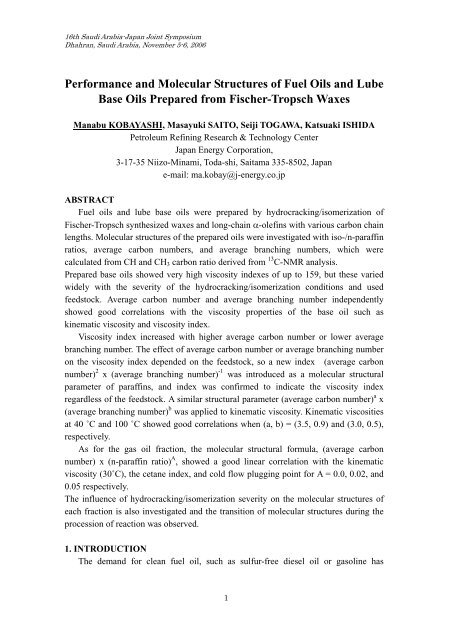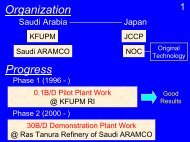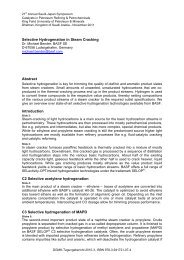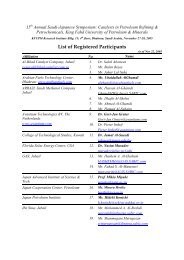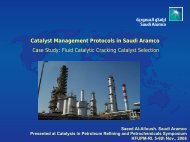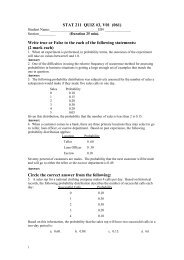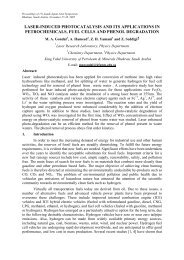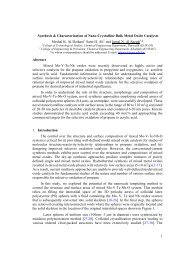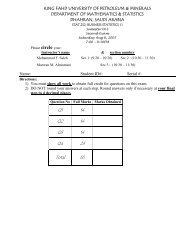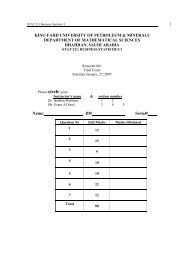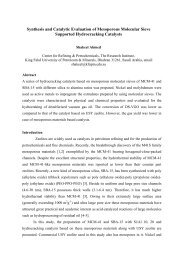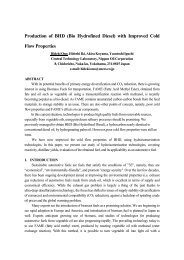Performance & Molecular Structure of Fuel Oils & Lube Base Oils ...
Performance & Molecular Structure of Fuel Oils & Lube Base Oils ...
Performance & Molecular Structure of Fuel Oils & Lube Base Oils ...
You also want an ePaper? Increase the reach of your titles
YUMPU automatically turns print PDFs into web optimized ePapers that Google loves.
16th Saudi Arabia-Japan Joint SymposiumDhahran, Saudi Arabia, November 5-6, 2006<strong>Performance</strong> and <strong>Molecular</strong> <strong>Structure</strong>s <strong>of</strong> <strong>Fuel</strong> <strong>Oils</strong> and <strong>Lube</strong><strong>Base</strong> <strong>Oils</strong> Prepared from Fischer-Tropsch WaxesManabu KOBAYASHI, Masayuki SAITO, Seiji TOGAWA, Katsuaki ISHIDAPetroleum Refining Research & Technology CenterJapan Energy Corporation,3-17-35 Niizo-Minami, Toda-shi, Saitama 335-8502, Japane-mail: ma.kobay@j-energy.co.jpABSTRACT<strong>Fuel</strong> oils and lube base oils were prepared by hydrocracking/isomerization <strong>of</strong>Fischer-Tropsch synthesized waxes and long-chain α-olefins with various carbon chainlengths. <strong>Molecular</strong> structures <strong>of</strong> the prepared oils were investigated with iso-/n-paraffinratios, average carbon numbers, and average branching numbers, which werecalculated from CH and CH 3 carbon ratio derived from 13 C-NMR analysis.Prepared base oils showed very high viscosity indexes <strong>of</strong> up to 159, but these variedwidely with the severity <strong>of</strong> the hydrocracking/isomerization conditions and usedfeedstock. Average carbon number and average branching number independentlyshowed good correlations with the viscosity properties <strong>of</strong> the base oil such askinematic viscosity and viscosity index.Viscosity index increased with higher average carbon number or lower averagebranching number. The effect <strong>of</strong> average carbon number or average branching numberon the viscosity index depended on the feedstock, so a new index (average carbonnumber) 2 x (average branching number) -1 was introduced as a molecular structuralparameter <strong>of</strong> paraffins, and index was confirmed to indicate the viscosity indexregardless <strong>of</strong> the feedstock. A similar structural parameter (average carbon number) a x(average branching number) b was applied to kinematic viscosity. Kinematic viscositiesat 40 ˚C and 100 ˚C showed good correlations when (a, b) = (3.5, 0.9) and (3.0, 0.5),respectively.As for the gas oil fraction, the molecular structural formula, (average carbonnumber) x (n-paraffin ratio) A , showed a good linear correlation with the kinematicviscosity (30˚C), the cetane index, and cold flow plugging point for A = 0.0, 0.02, and0.05 respectively.The influence <strong>of</strong> hydrocracking/isomerization severity on the molecular structures <strong>of</strong>each fraction is also investigated and the transition <strong>of</strong> molecular structures during theprocession <strong>of</strong> reaction was observed.1. INTRODUCTIONThe demand for clean fuel oil, such as sulfur-free diesel oil or gasoline has1
16th Saudi Arabia-Japan Joint SymposiumDhahran, Saudi Arabia, November 5-6, 2006increased with the rising concern about environmental issues such as emissions <strong>of</strong>particulate materials and Nox [1, 2]. Many refining companies have been developingmethods <strong>of</strong> production <strong>of</strong> fuel oils containing less than 10wtppm sulfur from crude oil.Gas-to-liquid (GTL) technology is expected to provide another method <strong>of</strong> producingcleaner fuel oils [3, 4, 5, 6].<strong>Fuel</strong> oils, such as kerosene or gas oil, which are derived directly fromFischer-Tropsch (FT) synthesis and indirectly via hydrocracking/isomerization <strong>of</strong> FTwax consist almost exclusively <strong>of</strong> n- and iso- paraffins. Therefore, the properties <strong>of</strong>fuel oils derived from FT synthesis depend on the branching state <strong>of</strong> the paraffins aswell as the carbon number distribution.Diesel oil is an effective application <strong>of</strong> fuel oil production from FT synthesis, asdiesel oil derived from the FT process (FT diesel) consists mainly nocyclic paraffinsand has excellent combustion properties, whereas diesel oils derived from crude oilinclude substantial amounts <strong>of</strong> aromatic compounds [7], which increase particulatematerial emission from vehicles. Diesel oil properties largely depend on the molecularstructural characteristics such as the content <strong>of</strong> n-paraffins, so control <strong>of</strong> molecularstructure is crucial to optimize the performance <strong>of</strong> diesel oil derived from FT synthesis[8].A great deal <strong>of</strong> effort has been devoted to the effect <strong>of</strong> the composition <strong>of</strong> FT dieselon combustion properties [9, 10, 11, 12], but information on the molecular structure <strong>of</strong>FT diesel remains insufficient, especially the effect <strong>of</strong> hydrocracking/isomerization onthe molecular structure.The recent tendency <strong>of</strong> clean fuel oils has also required improvement in theproperties <strong>of</strong> lube oil cleaner and more efficient as well. According to a recent survey[13], the total demand for lube base oil has been almost constant during the past twodecades, but the demand for high grade base oil (i.e. Group II or III) has graduallyincreased. <strong>Base</strong> oils prepared from paraffinic and clean source, such as FT synthesizedparaffin, are becoming more attractive as these products mainly consist <strong>of</strong> noncyclicparaffins and have very high viscosity indexes [14]. However, viscosity indexes <strong>of</strong>prepared lube oils varied widely and were strongly influenced by severity <strong>of</strong>hydrocracking/isomerization reaction.Authors attempted to describe the average molecular structures <strong>of</strong> each fraction byseveral parameters and correlate with properties <strong>of</strong> fuels or lube oils.One <strong>of</strong> the most fundamental structural parameters <strong>of</strong> base oil is the carbon numberdistribution, but this parameter is too complicated to relate to the performance <strong>of</strong> fueloils or lube base oil, so the average carbon number was taken as the parameter thatrepresents the size <strong>of</strong> molecule.Another important structural parameter is the branching <strong>of</strong> the paraffin molecule.<strong>Oils</strong> heavier than kerosene fraction contain so many isomers that it is impossible toidentify all isomers, for example by chromatography. One effective way to measure the2
16th Saudi Arabia-Japan Joint SymposiumDhahran, Saudi Arabia, November 5-6, 2006branching <strong>of</strong> base oil is to investigate the CH 3 carbon or CH carbon ratio using13 C-NMR. Assuming that there is no quaternary carbon atom, the peaks <strong>of</strong> 13 C-NMRcan be assigned to CH, CH 2 , or CH 3 carbon. Considering that base oil consists mainly<strong>of</strong> noncyclic paraffins, the average branching number can be calculated using the ratio<strong>of</strong> CH or CH 3 with average carbon number. Iso-/n-paraffin ratio is also important forthe oil properties.With these three parameters, average molecular structures <strong>of</strong> each fraction wasdescribed and compared with the severity <strong>of</strong> hydrocracking/isomerization reaction.Furthermore, average molecular structures <strong>of</strong> diesel oil fraction and lube base oilfraction were correlated with their properties, such as cetane index, cold filter pluggingpoint and viscosity <strong>of</strong> diesel oils and viscosity properties <strong>of</strong> lube oils respectively.2. EXPERIMENTAL2.1 Hydrocracking / Isomerization <strong>of</strong> FeedstockFT waxes (FTW-1 and 2) and long chain α-olefins (AO-1 and 2) were used asfeedstock. The carbon number distribution and other properties <strong>of</strong> feedstocks areshown in Table 1. Two types <strong>of</strong> catalysts were applied to hydrocracking/isomerizationreactions: CAT-A: mordenite-containing type [15], and CAT-B: amorphous type [16].Catalysts were filled in a fixed bed flow reactor with α-alumina as diluent. Beforeproviding feedstock, catalysts were sulfided with gas oil solution containing 1 vol%carbon disulfide. Liquid samples were obtained after oil/gas separation.Hydrocracking/isomerization conditions were as follows:H 2 pressure 4.0~9.0 MPa, H 2 /oil ratio 660~1500nL/L, operation temperature320~400˚C, liquid hourly space velocity, LHSV 0.33~2.00 h -1 .Table 1 Properties <strong>of</strong> Feedstocks (FT Waxes and α-olefins)FTW-1 FTW-2 AO-1 AO-2Density/15℃, g/cm 3 0.809 0.817 0.825 0.848Carbon Number Distribution C18-35 C19-54 C20-36 C28-46Iodide Number, g/100g-oil not analyzed not analyzed 73.9 39.1Number <strong>of</strong> Unsaturation, mol/mol not analyzed not analyzed 0.953 0.760IBP 316.0 343.0 336.5 430.0Distillation 10% 379.0 401.0 343.5 449.0Property, ℃ 50% 416.5 474.0 368.5 494.5(D-2887)90% 456.5 524.0 431.5 562.0EP 488.5 580.5 521.0 610.02.2 Separation and Analysis <strong>of</strong> Product <strong>Oils</strong>Liquid samples were separated into four fuel fractions: naphtha (boiling point3
16th Saudi Arabia-Japan Joint SymposiumDhahran, Saudi Arabia, November 5-6, 2006range: C5~150˚C), kerosene (150~250˚C), gas oil (250~360˚C), bottom oil (360˚C + )with the TBP (True Boiling Point) distillation apparatus.Fractionated samples were evaluated with 13 C-NMR (JEOL Ltd GSX-270 NMR)and the Distortionless Enhancement by Polarization Transfer (DEPT) method wasapplied to assign each peak to CH, CH 2 , and CH 3 carbon assuming that quaternarycarbon atoms were not present. Each peak was quantified by the analysis <strong>of</strong> 1 H gateddecoupling without NOE, because the peak area obtained by the DEPT method is notquantitative. N-paraffin contents <strong>of</strong> product oils were analyzed by gas chromatography.2.3 Determination <strong>of</strong> the Structural Parameters <strong>of</strong> Product <strong>Oils</strong>Average Carbon Numbers (ACNs):Average molecular weights <strong>of</strong> bottom oil were calculated from the kinematicviscosities at 37.8˚C and 98.9˚C by the ASTM D2502-92 method, and those <strong>of</strong>kerosene and gas oil by the method described in Procedure 2B2.1 in the Technical DataBook- Petroleum Refining <strong>of</strong> American Petroleum Institute. ACNs were calculatedwith Eq. (1), assuming that oil samples in this study consisted only <strong>of</strong> noncyclicparaffins with the molecular formula <strong>of</strong> C n H 2n+2 .ACN = (average molecular weight – 2) / 14 (1)Average Branching Numbers (ABNs):The ABNs were calculated with two methods [17]. As shown in Figure 1, ABN isequal to the average number <strong>of</strong> CH 3 carbons in one molecule minus 2 (Method A).ABNs can also be derived by counting CH carbon number in one molecule (Method B).Both CH 3 and CH carbon ratios were obtained from 13 C-NMR analysis, and bothmethods derived almost same values. Following discussions are employing ABNs byMethod A.Method A: ABN = ACN x CH 3 carbon ratio - 2 (2)Method B: ABN = ACN x CH carbon ratio (3)CH 3CHCH 3 Carbon :4CH Carbon :2Branching Number :2Fig. 1 <strong>Structure</strong> <strong>of</strong> 2 Branched Isoparaffin:Relationship <strong>of</strong> CH 3 , CH Carbon Ratio and BranchingNumber4
16th Saudi Arabia-Japan Joint SymposiumDhahran, Saudi Arabia, November 5-6, 20063. RESULTS AND DISCUSSION3.1 Influence <strong>of</strong> Reaction Severity on <strong>Molecular</strong> <strong>Structure</strong>The iso-/n-paraffin ratio increased with increased 360˚C + conversion in the gas oiland bottom fractions, increased to a lesser extent in the kerosene fraction, andremained almost constant in the naphtha fraction, regardless <strong>of</strong> the severity <strong>of</strong> thehydrocracking/isomerization reaction. This tendency can be interpreted by lowerreactivity <strong>of</strong> molecules with smaller carbon numbers.Average branching numbers <strong>of</strong> the isoparaffins were also compared with theseverity <strong>of</strong> the hydrocracking/isomerization reaction. Average branching numbers <strong>of</strong>the kerosene and gas oil fractions werenearly constant at approximately 1.3and 2.0 branch/molecule respectively,but were influenced by 360˚C +conversion in the bottom oil fraction.In the case <strong>of</strong> FTW-1, even at very lowconversion (below 10 weight %),about 2 branches were generated(Figure 2). With increased conversion,ABN increased up to 2.4 and otherfeedstocks showed similar trends.These results show that the formation<strong>of</strong> the first and second branches in theparaffin chain is a very quick reaction.On the other hand, the formation <strong>of</strong> thethird and subsequent branches iscomparatively slow or multi-branchedisoparaffins are easy to be converted tolighter fractions.fAverage Branching Number oIsoparaffin in Bottom Oil4.03.02.01.00 25 50 75 100360ºC + Conversion, wt%FTW-1 FTW-2 AO-1 AO-2Fig.2 Correlation beween 360ºC +Conversion and Average BranchingNumber <strong>of</strong> <strong>Lube</strong> <strong>Base</strong> Oil3.2 Properties and <strong>Molecular</strong> <strong>Structure</strong>s <strong>of</strong> Prepared <strong>Lube</strong> <strong>Base</strong> <strong>Oils</strong>Most <strong>of</strong> prepared base oils have very high viscosity indexes from 130 up to 159.However, one sample had a relatively lower viscosity index (113.8).The viscosity index was drastically lowered with increased conversion with everyfeedstock. These changes can be attributed to structural changes <strong>of</strong> the isoparaffinswhich form the base oils. 360˚C + conversion was varied by changing both operationtemperature and liquid hourly space velocity, LHSV. However, properties <strong>of</strong> base oilsor molecular structure changes could be described as a function <strong>of</strong> only 360˚C +conversion, that is 360˚C + conversion is the only index that represents the severity <strong>of</strong>the hydrocracking/isomerization reaction.These findings suggest some kind <strong>of</strong> correlation <strong>of</strong> ACN and ABN with the5
16th Saudi Arabia-Japan Joint SymposiumDhahran, Saudi Arabia, November 5-6, 2006viscosity indexes as shown in Fig. 3 and correlation curves depend on the feedstock.These results indicate that both ACN and ABN are important factors for the viscosityindex. Therefore, we attempted to describe viscosity indexes as a function <strong>of</strong> ACN andABN with following Eq. (4).180180Viscosity Index160140120Viscosity Index16014012010020 25 30 35 401001 2 34Average Carbon NumberAverage Branching NumberFTW-1 FTW-2 AO-1 AO-2Fig.3 Correlation between Average Carbon Number,Average Branching Number and Viscosity Index <strong>of</strong> <strong>Lube</strong> <strong>Base</strong> Oilviscosity index = f{(ACN) a x (ABN) b } (4)Using (a, b) = (2, -1) as multipliers, Eq. (4) and viscosity index showed goodcorrelation as a quadratic curve regardless <strong>of</strong> used feedstock as shown in Figure 4. Thisresult shows that viscosity indexes <strong>of</strong> base oils prepared byhydrocracking/isomerization <strong>of</strong> waxy feedstock can be determined as a function <strong>of</strong>ACN and ABN. The obtained formula (ACN) 2 x (ABN) -1 was factorized as shown inEq. (5) to analyze the adopted multipliers. The viscosity index can be expressed bymultiplication <strong>of</strong> a function that expresses the size <strong>of</strong> the molecule (ACN) and afunction that relates to the methylene chain length <strong>of</strong> the paraffin ((ACN) x (ABN) -1 )).(ACN) 2 x (ABN) -1 = (ACN) x {(ACN) x (ABN) -1 } (5)Similar formula, (ACN) a x (ABN) b was applied to kinematic viscosities at both 40˚C and 100 ˚C. By employing (a, b) = (3.5, 0.9) for the viscosity at 40 ˚C and (3.0, 0.5)for the viscosity at 100 ˚C, good linear relationships between viscosity and molecularstructural parameter (ACN) a x (ABN) b were obtained as shown in Figures 5. Theseresults indicate that though molecular size is the dominant factor for kinematicviscosity, branching state is also influential.It may seem a little strange that the viscosity indexes could be represented only by6
16th Saudi Arabia-Japan Joint SymposiumDhahran, Saudi Arabia, November 5-6, 2006improved with increased 360˚C + conversion. This is supposed to be due to the increasein the light naphtha (LN) fraction that has higher RON than heavy naphtha (HN).Table 2. Properties <strong>of</strong> Naphtha Fraction <strong>of</strong> Product OilOperation 360ºC + iso/n Ratio RON YieldTemperature Conversion LN HN whole LN HN whole HN/(LN+HN)ºC wt% wt%/wt% - wt%/wt%380 35.5 2.0 2.7 2.6 68 35.2 43.6 75.0390 68.0 2.1 2.9 2.7 70.8 37.1 47.5 67.8400 91.5 - - 2.5 - - 50.2 52.24. CONCLUSION<strong>Fuel</strong> oils and lube base oils were prepared by hydrocracking/isomerization <strong>of</strong>Fischer-Tropsch synthesized waxes and long-chain α-olefins with various carbon chainlengths. Prepared diesel oils and lube base oils showed very high cetane index andviscosity index respectively as they virtually consisted <strong>of</strong> only noncyclic paraffins.In order to describe molecular structures <strong>of</strong> product oils, three structural parameters(“iso-/n-paraffin ratio”, “average carbon number”, and “average branching number”)were introduced.Hydrocracking/isomerization severity is highly influential on these parameters inbottom oil, however average molecular structures are almost constant in naphtha andkerosene that is supposedly due to low reactivity <strong>of</strong> shorter chain paraffins than longerones.These parameters were well correlated with properties <strong>of</strong> diesel oil or lube base oils,but the correlations depend on the employed feedstocks. By employing new indexesthat are expressed by combination <strong>of</strong> these parameters, properties <strong>of</strong> diesel and lubebase oil could be expressed regardless <strong>of</strong> used feedstock.5. REFERENCES[1] Uchiyama, S., Journal <strong>of</strong> Society <strong>of</strong> Automotive Engineers <strong>of</strong> Japan, 58, (11), 83,(2004).[2] Matsuo, S., Takami, K., Yamamoto, H., Journal <strong>of</strong> Society <strong>of</strong> AutomotiveEngineers <strong>of</strong> Japan, 58, (11), 89, (2004).[3] Ondrey, G., Chem.Eng., 111, (5), 23, (2004).[4] Skrebowski, C., Petroleum Review, 691, (58), 18, (2004).[5] Morita, Y., Enerugi Keizai, 28, (1), 1, 2002.[6] Matsubara, H., Journal <strong>of</strong> Society <strong>of</strong> Automotive Engineers <strong>of</strong> Japan, 58, (11), 41,(2004).[7] Myburgh, I., Schnell, M., Oyama, K., Sugano, H., Yokota, H., Tahara, S., Prepr.SAE2003-01-1946, (2003).9
16th Saudi Arabia-Japan Joint SymposiumDhahran, Saudi Arabia, November 5-6, 2006[8] Bisio, A., Atkinson, C., Prepr Pap Am. Chem. Soc. Div <strong>Fuel</strong> Chem., 47, (2), 496,(2002).[9] Nishiumi, R., Yasuda, A., Tsukasaki, Y., Tanaka, T., SAE Tech. Pap. Ser (SocAutomot Eng), (2004).[10] Alleman, T. L., Mccormick, R. L., “Spec. Publ. Soc. Automot. Eng.”, (2003),p.185-204.[11] Gjirja, S., Olssone, E., Eklund, A., Proc. Int. Symp. Automot. Technol. Autom.2000, (2000), p.105-115.[12] Erwin, J., Prepr. Pap. Am. Chem. Soc. Div. <strong>Fuel</strong>. Chem., 37, (4),1915, (1992).[13] Gelder, A., Fourth ICIS-LOR World base Oil Conference, London, 2000[14] Igarashi, J., Tribologist, 48, (4), 265, (2003).[15] Arima, Y., Jpn. Toroku Tokkyo Koho JP2901047 (1999).[16] Ishida, K., Saito, T., Kobayashi, M., Matsuzawa, K., Jpn. Toroku Tokkyo KohoJP3662495 (2005).[17] Kobayashi, M., Saitoh, M., Ishida, K., Yachi, H., Journal <strong>of</strong> the Japan PetroleumInstitute, 48, (6), 365, (2005).[18] Properties <strong>of</strong> Hydrocarbons <strong>of</strong> High <strong>Molecular</strong> Weight, API Research Project 42Report, 1967.[19] Kobayashi, M., Togawa, S., Ishida, K., Journal <strong>of</strong> the Japan Petroleum Institute,49, (4), 194, (2006).[20] Matsushita, K., Kobayashi, M., Yachi, H., Matsui, J., 34th Petroleum &Petrochemical Symposium <strong>of</strong> Jpn. Petrol. Inst., Matsuyama, November 2004,Abstr., p.273-274.10


